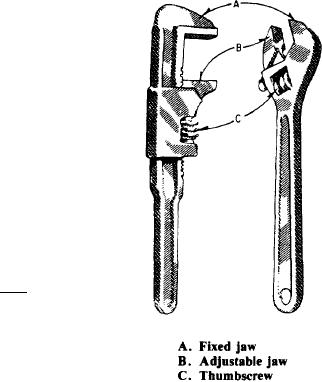
OPEN-END WRENCH.-- The jaws of the
open-end portion of the combination wrench are
machined at 15 degrees from parallel in respect
to the center line of the handle. This permits the
use of the wrench where there is room to make
only a part of a complete turn. If the wrench is
turned over after the first swing, it will fit on the
same flats and turn the nut farther. After two
swings on the wrench, the nut is turned far enough
so that a new set of flats are in position for the
wrench.
Use the open end of the combination wrench
on tubing nuts and in cramped places. Sometimes
the cramped space is too small for a socket or box-
end to be slipped over the nut or bolt head. When
using any open-end type wrench, always make
sure the wrench fits the nut or bolt head, and pull
on the wrench--never push. Pushing a wrench is
dangerous. The threads could break loose un-
expectedly and cause damage to adjacent equip-
ment or injury to the person using the wrench.
ADJUSTABLE WRENCHES.-- Adjustable
Figure 2-5.-Adjustable wrenches.
wrenches are not intended to replace open-end or
box-end wrenches, but they are useful in work-
ing in restricted areas. In addition, they can be
work will not allow all four steps to be followed,
adjusted to fit odd size nuts. Adjustable wrenches
are not intended for standard use but rather for
select another type of wrench for the job.
emergency use. The wrenches were not built for
Adjustable wrenches should be cleaned in a
solvent, and a light oil applied to the thumbscrew
use on extremely hard-to-turn items. As shown
in figure 2-5, adjustable wrenches have a fixed jaw
and the sides of the adjustable jaw. They should
(A) and an adjustable jaw (B), which is adjusted
also be inspected often for cracks, which might
by a thumbscrew (C). By turning the thumbscrew,
result in failure of the wrench.
the jaw opening may be adjusted to fit various
sizes of nuts. The size of the wrenches ranges from
Screwdrivers
4 to 18 inches in length. The maximum jaw open-
ings vary in direct proportion to the length of the
Two basic types of screwdriver blades are
handle.
used: the common blade for use on conventional
Adjustable wrenches are often called "knuckle
slotted screws, and a crosspoint blade for use on
the recessed head Phillips or Reed and Prince type
busters" because mechanics frequently suffer the
of screws. See figure 2-6. The common and cross-
consequences of improper usage of these tools.
There are four simple steps to follow in using
point blade types are used in the design of various
special screwdrivers, some of which are also
these wrenches. First, choose one of the correct
shown in figure 2-6.
size. Do not pick a large 12-inch wrench and
adjust the jaw for use on a 3/8-inch nut. This
COMMON SCREWDRIVERS.-- The com-
could result in a broken bolt and a bloody hand.
Second, be sure the jaws of the correct size wrench
bination length of the shank and blade identifies
are adjusted to fit snugly on the nut. Third,
the size of common screwdrivers. They vary from
2 1/2 to 12 inches. The diameter of the shank and
position the wrench around the nut until the nut
the width and thickness of the blade tip, which
is all the way into the throat of the jaws. If not
fits the screw slot, are in proportion to the length
used in this manner, the result is apt to be as
of the shank. The blade is hardened to prevent
bloody as before. Fourth, pull the handle toward
it from being damaged when it is used on screws.
the side having the adjustable jaw. This will
It can easily be chipped or blunted when used for
prevent the adjustable jaw from springing open
other purposes. The blade of a poor quality
and slipping off the nut. If the location of the
2-6

